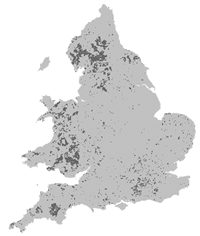 |
|||||||||
|
||||||||||||||||||||
| news index | Common
Management
More than half the area of the common land in England and Wales is in the northern counties of England – with Cumbria alone having 300,000 acres, representing 30 per cent of the total and a further 200,000 acres in Yorkshire. In Durham there are 60,000 acres of common land and there are large commons in Northumberland in Allendale and Hexhamshire – as well as the Town Moor, Newcastle. The consultation launched by rural affairs minister Alun Michael, marks the culmination of more than 50 years of attempts to address the management of common land which began after the Second World War and it gives those with commons rights the final opportunity to express their views before legislation. “ One of the most important aspects which should emerge from this consultation is that it will be able to empower commoners,” said Andrew Humphries, of Ivegill, Carlisle, who is adviser to the Cumbria Federation of Commoners – the first federation in England and Wales which was officially set up earlier this year. “ At the moment commoners are being held accountable without being able to do anything about the issues themselves. The outcome of these consultations should give individual commoners associations the capacity to pass legal rules and by-laws to bring about local management of commons,” he said. Rural Affairs Minister Alun Michael said: "Common land is part of our heritage and a valuable resource - it is valued for nature conservation, landscape and recreation, and is an essential component of the agricultural economy, particularly in upland areas. That is one reason why we need to create a more effective management structure. " And this is just as important for wildlife. Around half of all common land in England and Wales is designated as sites of special scientific interest and a third of the land area lies within the boundaries of Environmentally Sensitive Areas. " At present, it can be an uphill task to find agreement among the many commoners, landowners and others with an interest in the common on how best to manage it. Sometimes people fail to find a consensus and the common deteriorates. " Overgrazing and poor management are causing the variety of species to diminish in many, particularly upland, commons. At the same time, undergrazing, and the withdrawal of commoners' livestock, are having an adverse impact on many other, largely lowland, commons. " The measures we are consulting on are designed to help facilitate better management. Commoners and land managers have told us that they want powers to effectively self-regulate and improve the management of common land - our proposals are designed to make this possible. “ Our proposals will bring commoners, owners and others together in statutory commons associations, with powers of self-regulation in the interests of sustainable agricultural management. This is a new opportunity for those interested in commons to demonstrate that they can effectively manage their affairs and the commons to the benefit of both their agricultural interests and the wider environmental and biodiversity interests.” Richard Ellison, NFU North East regional director, said: "Clearly these proposals will affect a large number of farmers and landowners within the North East region and the NFU looks forward to participating fully in the consultation process." It was after the war that the hill farming committee of England and Wales set up to advise government began to look at the issues of sustainable management of commons because of the push on agricultural production.
The consultation paper builds on the recommendations to Government of the Stakeholder Working Group issued in April 2003. Defra and the Welsh Assembly Government are inviting comments on the consultation by 14 November this year. |
|||||||||||||||||||

|
|
|||||||||||||||||||
| home | agri-services | pedigree
pen | news | dairy | beef | machinery property | organisations | site map |
||||||||||||||||||||
